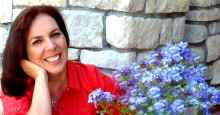Even though I’m in Greece right now and I’ll be spending the next few weeks visiting family, friends and maybe a few of our favorite places, I really wanted to show you a couple of projects that are already finished in our San Francisco Bay Area home, which I didn’t have the time to post.
While I was putting away the school work that my son brought home (and that was not used on my Wall Gallery), I followed this little annual ritual of mine and spent a few minutes going through the drawers that hold my children’s artwork from their earlier ages. Drawings have been accumulating over the years and I miss having them around the house. But I never really liked the “refrigerator & magnet” nor the “tape on the wall” hanging methods, although I cannot deny that I did use them from time to time. Plus, how many drawings can you really have around the house?
So I just came up with these wooden panels that each include drawings that have been photocopied and then transferred onto the panel. To make them more interesting, I added a little frame and I quite liked the result!
Here is how I made them:
I started by painting two plywood panels (from the hardware store) in a light gray color and let them dry.
I then made colored copies of my favorite drawings on a reduced scale.
On a clean preparation surface (here a sheet of aluminum foil) I applied a thick coat of Photo Transfer Medium on the good side of each photocopy
and placed it inverted, good side down, on the painted wooden panel. It’s important to calculate beforehand each exact spot before placing the coated image on the panel. I let them sit for 24 hours, as per instructions and…
…removed the photocopy paper by rubbing gently with a soft wet sponge to reveal the image! Once the paper has been completely removed, the image is part of the wood as if it was painted on it! Isn’t this amazing?
To add some texture and interest onto the panels, I framed each photo with balsa wood strips that I painted in a dark blue color. Balsa wood is an inexpensive craft material so soft that it can be cut with a knife but looks like real wood. Each strip was cut to size and, for a more professional result, at 45 degree angles, and glued with simple glue stick.
The frame is not only a decorative addition but it also covers the perimeter of the transferred image and straightens the borders creating clean lines all around.
As some of the frames didn’t connect perfectly well on the corners, I added some wood filler in between the gaps and, when dry, I used a very thin brush to paint over with the same blue color.
To hang the panels on the wall, I added a Sawtooth picture hanger on the back of each panel.
And as a final step, I applied some gloss finish to revive the color that seemed to have slightly faded after the photo was transferred.
To transfer images with words, make sure you reverse on your copier. I didn’t have to, because I had no wording, so you can see that each transferred image is reversed compared to its original, but I’m sure that the artist will not mind!
By reducing each image in size, you can have a lot more drawings into a smaller area. And by transferring them onto a panel, they are now permanent and in a more organized way. You can make larger panels to hold more drawings, or categorize them into subjects or maybe by year. They make a great present to grandparents and other family members, too!
I ‘ve always encouraged my children to title their drawings and always had it written on the back of the drawing along with the date. To retain these little details, I added a label under each artwork.
The Photo Transfer Medium works only with photocopies. For a better results and techniques, I followed an online tutorial.
This is definitely the best way to enjoy our kids’ artwork!

















